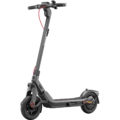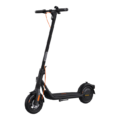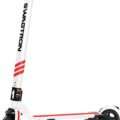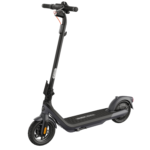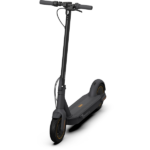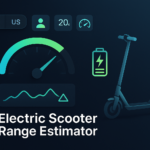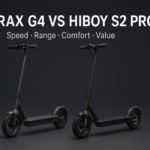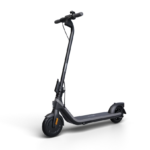- Home
- Scooters
- Electric Scooters
- Segway Ninebot P100SE
Segway Ninebot P100SE



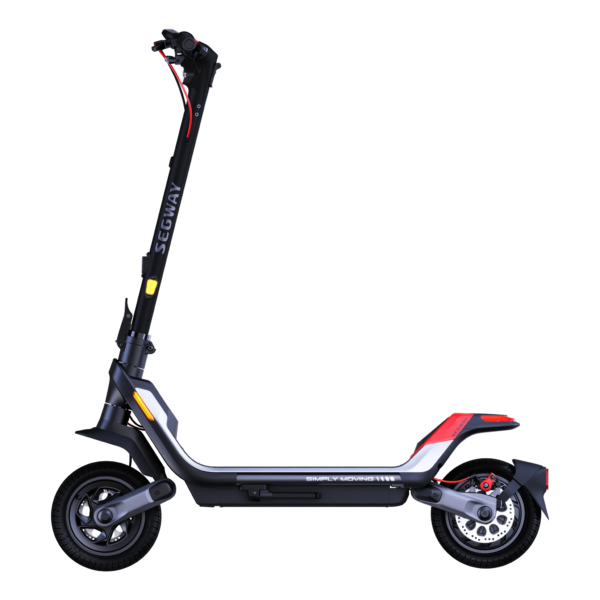
- Battery Range: Up to 100 km
- Top Speed: 25 km/h (EU cap)
- Motor Power: 650 W nominal
- Weight Capacity: 120 kg
- Charging Time: ≈7 h
- Scooter Weight & Portability: 32.9 kg
PROS
- 1086 Wh battery delivers genuine long-range commuting
- Dual-arm suspension + 10.5″ self-sealing tyres improve comfort and uptime
- Triple-brake system, bright lighting, and integrated indicators boost safety
CONS
- 32.9 kg weight limits frequent stair carries
- 25 km/h EU cap may feel restrictive on open paths
Overview
Meet the Segway Ninebot P100SE
The Segway Ninebot P100SE is the EU-spec sibling of the P100S, tuned for regulated markets and built for riders who want real range, real comfort, and real safety features without stepping into the complexity of dual-motor hyper scooters. It blends a substantial 1086 Wh battery with a planted chassis, dual-arm suspension, and a triple-brake system, all wrapped in a package that prioritizes confidence, visibility, and low-drama control. The result is a long-range commuter that feels legitimately premium while still staying approachable.
Crucially, the P100SE caps speed at 25 km/h, as required in many EU regions. However, it counters that limit with stamina, stability, and serious braking headroom. Therefore, it suits riders who value consistent control, steady comfort, and predictable ownership costs over headline top-end numbers. As you’ll see throughout this Segway Ninebot P100SE review, the spec sheet aligns cleanly with the real-world ride.
Who the P100SE Is For
Every scooter finds its rider. The P100SE serves people who commute medium to long distances on mixed city surfaces, prefer a calm, confidence-inspiring chassis, and want safety features that truly matter in traffic. It targets professionals who split days between office, campus, and errands. It supports heavier riders up to 120 kg who appreciate a stable deck and wide bars. It also rewards anyone who rides year-round and values traction, lighting, and clear turn indicators when conditions get sketchy.
Meanwhile, it is not chasing sport thrills. If your joy comes from sprinting above bike-lane pace, you will bump against the EU limiter. Yet for most urban contexts, the limiter actually matches reality. Bike lanes typically flow below 25 km/h, and what you need most is composure, not chaos. In that lane, the P100SE thrives.
Design Philosophy: Confidence First
Segway’s P-series philosophy emphasizes composure under stress. Rather than saving grams at all costs, the P100SE leans into a robust frame, predictable geometry, and tidy cable routing. Consequently, it rides quietly and tracks straight even as tyres wear in. You notice the solidity when you cross expansion joints or breeze through gusty corridors between buildings. Nothing rattles, nothing chatters, and nothing demands constant correction.
Furthermore, the controls sit exactly where your hands expect. The dashboard is readable in sunlight. The indicator buttons live within easy reach. The levers feel firm without being wooden. As a result, the scooter fades into the background while you scan for traffic cues. That is what good commuter design feels like: it reduces cognitive load rather than adding tasks.
Motor Character: Smooth Over Showy
The P100SE uses a rear-hub motor tuned for linear, predictable thrust. Launches feel progressive rather than abrupt, which is perfect around pedestrians and parked cars. Rolling the throttle mid-corner doesn’t jolt the chassis; it simply adds a touch more pace. Because the drive is in the rear, weight transfer improves grip as you accelerate, which steadies the exit of slow corners and wet zebra crossings.
Importantly, the tune respects the 25 km/h cap without feeling suffocated. Eco mode saves watts for winter days and long returns. Drive mode becomes the everyday choice, balancing thrust and range. Sport wakes up the response for short, urgent merges. Therefore, you can match behavior to context without fuss or menus.
Speed Where It Matters
Spec sheets love big numbers; cities do not. In actual bike lanes, stability, braking, and visibility decide outcomes far more often than raw speed. Here, the P100SE shines. At 20–25 km/h it tracks arrow-straight. It shrugs off small seams, paint lines, and light crosswinds. Accordingly, your hands relax, your shoulders drop, and you stop fighting the scooter. That calm posture helps you ride safer and farther, day after day.
Even better, the scooter remains steady when you shoulder-check, signal, and reposition. Because the deck sits low and the bars are wide, weight shifts feel natural. You stay composed during merges, you stay visible during turns, and you stay confident when paths get crowded.
Battery Capacity and Real-World Range
A headline figure of 1086 Wh changes daily habits. With that capacity, the P100SE carries you through a round-trip commute, a lunch detour, and an evening errand without the anxious math. Under gentle conditions, you may approach the rated 100 km. Under brisk riding or colder weather, you will see less, yet you still retain a generous reserve. Consequently, you plan days around appointments, not outlets.
Additionally, a big battery pairs naturally with lower stress. You can cruise in Drive or Eco and still arrive on time. You can ride around headwinds rather than through them. And you can prioritize smoothness over sprinting because the range margin lets you. That margin is the real quality-of-life upgrade for long-haul commuters.
Charging: Predictable and Simple
The P100SE includes an onboard charger, so you carry only a light AC cable. You plug into any standard outlet and the scooter handles the rest. Because charge time sits around seven hours from low state of charge, evening top-ups fit naturally into home routines. You plug in after dinner and wake to full range. There is no brick to forget, no cable spaghetti to organize, and no clunky adapters to babysit.
Moreover, lithium cells thrive on moderation. Opportunistic top-ups during the week keep the pack happy. Avoiding deep discharges extends lifespan. Storing at room temperature preserves capacity. Fortunately, the display and app make state-of-charge simple to read, so good habits become easy, not academic.
Suspension and Tyres: Real Comfort, Real Control
Comfort does not require exotic linkages. The P100SE uses dual-arm suspension front and rear to filter sharp edges and repetitive chatter. Combined with higher-volume 10.5-inch self-sealing tyres, it turns ragged asphalt into a gentle hum. Set pressures correctly and the chassis feels composed rather than floaty. You still respect square-edged potholes, yet everyday cracks stop feeling like events.
The tyres themselves carry a puncture-resistant jelly layer. Therefore, tiny intrusions often seal before pressure loss strands you. City commuters know how much a flat derails a morning. Reducing that risk pays back in fewer delays and fewer late arrivals.
Braking: Triple System Confidence
Stopping is where many scooters cut corners; the P100SE does not. It combines a front disc, a rear disc, and rear electronic regenerative braking. On dry pavement, lever feel is linear and predictable. On wet mornings, regen smooths deceleration while the discs keep authority. Because the system has headroom, you can brake earlier and smoother, which keeps the chassis settled and your line clean.
Practice matters too. Spend ten minutes in a quiet lot exploring hard stops. Learn the threshold where tyres begin to talk. Map lever travel and weight shift. After that session, emergency stops feel less like panic and more like procedure. Confidence is cumulative, and this system supports it.
Lighting, Indicators, and Visibility
Being seen is as important as seeing. The P100SE equips a bright headlight, DRL, a responsive tail/brake light, and certified reflectors. Most importantly, it builds turn indicators into both ends of the scooter. These indicators broadcast intent clearly, especially in winter twilight when hand signals disappear against dark jackets. Because the control sits under your thumb, you signal without hunting for buttons.
Furthermore, layered visibility reduces surprises. Drivers register your presence earlier. Cyclists interpret your next move faster. Pedestrians understand your path at a glance. Consequently, interactions feel calmer and safer, which makes long days less exhausting.
Smart App Features That Actually Help
Useful software choices beat flashy gimmicks. The Segway app lets you pair quickly, set speed caps, tune regeneration, apply firmware updates, and lock the motor. You can also review ride stats and health data that make maintenance proactive rather than reactive. Nothing requires constant tinkering; you set preferences once and ride.
Additionally, security layers stack. An electronic alarm warns curious hands. NFC and password unlock add convenient control. A sturdy physical lock still matters for real deterrence, yet digital layers shorten time-to-awareness when you step away for coffee. Together, these features minimize friction without demanding attention.
Ergonomics, Cockpit, and Daily Controls
Daily comfort lives in details. The bars are wide enough for leverage but not bus-door wide. The throttle feels light, so your thumb does not fatigue. The brake levers clear winter gloves. The deck offers room for a relaxed, staggered stance that keeps knees and hips happy. Even the kickstand location helps, because the scooter settles predictably when you park quickly at a shop.
Moreover, the display presents only what matters: speed, mode, battery, and essential icons. Sunlight legibility stays strong, and night glare remains low. You glance, you understand, and you return to the lane. Simplicity reduces mistakes, and the cockpit gets that balance right.
Handling on Mixed Surfaces
Urban routes rarely stay perfect. One block is new asphalt, the next is patched concrete, and the third is pavers with seams. The P100SE adapts gracefully. Its suspension takes the sting out of transitions. Its steering remains calm over paint lines and utility cuts. Its tyres keep grip through damp leaves and dusty shoulders when you ride with reasonable inputs.
Accordingly, the scooter invites smooth technique. Look through corners, roll on gently, and let the chassis carve. It rewards that approach with tidy arcs and quiet composure. Even on longer days, fatigue stays low because you are not wrestling or overcorrecting every minute.
Portability: Manageable but Not Featherweight
At roughly 32.9 kg, the P100SE is not built for frequent stair carries. However, the fold is positive, and the footprint tucks beside a desk or café table. For rail segments, rolling beats lifting. When you must lift, hold the mass close to your body and keep steps deliberate. The payoff for that heft arrives on the road, where the scooter’s stability turns windy commutes into routine rides.
If you live on a third-floor walk-up, consider storage on the landing or a ground-floor lockable area. If you carry the scooter occasionally, you will adapt. If you carry it constantly, you may prefer a lighter MAX-class model. Choosing honestly saves frustration later.
Maintenance That Respects Your Time
Ownership should be predictable. Check tyre pressure weekly with a reliable gauge. Spin wheels to listen for rub. Squeeze the levers to confirm consistent travel. Inspect the folding latch monthly and snug hardware to spec. Wipe down after wet rides. Update firmware only after skimming notes, and skip beta curiosities during busy weeks. These small habits take minutes but prevent bigger headaches.
Notably, the self-sealing tyres reduce flat frequency, and the triple-brake system wears gracefully rather than suddenly. As pads age, feel changes gradually, which gives ample time for scheduling service. The scooter’s cable routing also avoids sharp bends that chew housings. Consequently, the to-do list stays short for long stretches.
Cold Weather and Seasonal Strategy
Winter rides change range dynamics. Lithium chemistry dislikes cold, so plan slightly earlier charges and expect a few fewer kilometers. Choose Drive or Eco on frigid mornings to preserve watts. Inflate tyres to the low end of the recommended window for grip on slick surfaces, yet avoid under-inflation that saps range. After wet rides, wipe the scooter and store it warm enough for moisture to evaporate.
Conversely, summer heat asks for moderation too. Do not bake the scooter in a closed car. Avoid charging at extreme temperatures. Keep pressures within spec to prevent sidewall stress. With these simple habits, the P100SE remains a reliable partner across seasons.
Safety Mindset and Best Practices
Hardware enables safety, but habits deliver it. Signal early and decisively. Make eye contact at intersections. Brake sooner than you think in the wet. Scan for doors and dogs on shared paths. Leave room for errors—yours and theirs. Because the P100SE provides braking headroom and visibility tools, it supports these habits rather than fighting them. Over time, that support translates into fewer near misses and calmer commutes.
Furthermore, pair the scooter with a bright auxiliary headlight if you ride pitch-black paths. Add a reflective ankle band for motion-based visibility. Wear gloves for grip consistency. These small additions amplify the stock package without complicating it.
Comparisons That Clarify Decisions
Shoppers often weigh the P100SE against three groups. First, lighter commuters around 15–20 kg. Those models carry easier but give up suspension travel, braking reserve, and long-haul range. The P100SE beats them on comfort and composure, especially on rougher routes. Second, MAX-class singles. MAX models lighten the load and still offer excellent range, yet they lack the P100SE’s dual-arm suspension and triple-brake confidence. If your streets are patchy or your days run long, the P100SE’s comfort adds real value.
Third, dual-motor sport machines. They surge harder and climb faster, but they add weight, cost, and maintenance. If you crave speed highs, they are wonderful. If you want a dependable, predictable commuter with deep stamina and serious safety features, the P100SE remains the saner choice. It respects your time, your energy, and your wallet over months, not minutes.
Total Cost of Ownership
Real value appears after the honeymoon. A scooter that needs constant tweaks or frequent tyres eats both money and time. The P100SE’s self-sealing tyres, stable hardware, and predictable brake wear shrink that tax. Meanwhile, the onboard charger eliminates a separate brick, which reduces cable failures and adapter drama. Over a year, these small advantages compound into lower stress and lower spend.
Additionally, resale favors models with reputations for durability. Because the P100SE shares DNA with the P100S and sits within Segway’s well-known ecosystem, parts, tutorials, and community support remain easy to find. That ecosystem matters when you decide to service or sell.
Where the P100SE Isn’t Ideal
No product fits everyone. If you live up multiple flights and must carry daily, weight will frustrate you. If your city allows higher speed limits and you like fast sprints, the EU cap will feel confining. If your streets are pristine and you ride short loops, you may not need dual-arm suspension at all. Honesty about your route and routines pays off at checkout. Buy for ninety percent of your rides, not the rare edge case.
Even so, the P100SE can handle occasional stairs, occasional hills, and occasional rough patches. It just won’t transform into a featherweight or a race scooter. It remains what it is designed to be: a long-range, confidence-first commuter with comfort and safety baked in.
Segway Ninebot P100SE Specifications in Context
Numbers only matter when they match needs. Here, the Segway Ninebot P100SE specifications line up well with urban realities: a 1086 Wh battery for long days, dual-arm suspension for comfort, triple brakes for real stopping power, and integrated indicators for clear communication. Add IPX5 water resistance for drizzle days and a sturdy frame for quiet tracking. Put it together, and you get a scooter that meets the city where it lives—crowded, imperfect, and fast-changing.
Ultimately, the spec sheet explains why the ride feels the way it does. The battery supports calmer modes. The suspension filters repetitive jolts. The brakes build trust quickly. The indicators reduce ambiguity. Therefore, you ride more, worry less, and arrive fresher.
Final Verdict
The Segway Ninebot P100SE is a grown-up commuter for riders who value consistency over spectacle. It trades sprint drama for stability, and it swaps spec-sheet flash for features that matter every single day. If your routine spans real distance, if your streets mix surfaces, and if your priorities include safety, comfort, and low-maintenance ownership, this scooter fits. It will not win drag races, yet it will win your weekdays. In the end, that reliability is the point.
Specifications
General
| Model The Model specifies the exact version or name of the scooter. It helps identify its unique design, features, and specifications within the manufacturer’s product line. Knowing the model makes it easier to compare options, find compatible accessories, or look up support information. | Ninebot P100SE |
| Brand The Brand identifies the manufacturer or company that designs and produces the scooter. A trusted brand is a sign of quality, reliability, and good customer support. Well-known brands often have higher standards for safety, performance, and after-sales service, giving you more confidence in your purchase. | Segway |
| Release Date The Release Date indicates when the scooter model was officially launched on the market. This helps you know how current the design, technology, and features are. A newer release date often means updated components, improved performance, and the latest safety or smart features. | 17 November 2025 |
| Recommended Age Recommended Age indicates the minimum age range that the scooter is designed for, based on safety, size, and ease of use. Following the recommended age helps ensure that riders can handle the scooter’s speed, weight, and controls comfortably and safely. Always check local laws and use protective gear, especially for younger riders. | 16+ |
Performance & Power
| Motor Power (Wattage) What it means: The motor power, measured in watts (W), shows how strong the scooter’s electric motor is. Why it matters: Higher wattage usually means better acceleration, more torque, and improved performance on hills or rough terrain. For example, a 250W motor is good for flat city roads and light riders, while a 500W or 1000W motor provides more power for faster speeds or climbing steep inclines. | 650 W nominal (1350 W peak) |
| Top Speed The Top Speed indicates the maximum speed that the scooter can reach under optimal conditions. It’s usually measured on level ground with a fully charged battery and an average rider weight. A higher top speed allows you to travel longer distances faster, but always ensure you ride within legal speed limits and your personal comfort zone for safety. | 25 km/h |
| Battery Capacity Battery Capacity refers to the total amount of energy the scooter’s battery can store, usually measured in ampere-hours (Ah) or watt-hours (Wh). A higher battery capacity means you can ride longer distances on a single charge, reducing the need for frequent recharging. Keep in mind that actual range can vary depending on rider weight, terrain, speed, and weather conditions. | 1086 Wh (23 Ah, 47.2 V nominal) |
| Estimated Range per Charge The Estimated Range per Charge indicates the average distance the scooter can travel on a single full battery charge. This range is calculated under optimal conditions, such as flat terrain, moderate speed, and average rider weight. Real-world range may vary depending on riding style, terrain, weather, and load. A longer range means fewer recharges and greater freedom for longer trips. | Up to 100 km (theoretical) |
| Hill Climb Ability Hill Climb Ability describes the maximum incline or slope that the scooter can handle while maintaining stable performance. It’s typically expressed as a percentage or in degrees. A higher hill climb rating means the scooter can tackle steeper hills without losing too much speed or power. Actual climbing performance may vary based on rider weight, battery charge, and terrain conditions. | Up to 23% grade |
| Drive System The Drive System refers to how power from the motor is delivered to the wheels. Electric scooters typically use either a hub motor (directly integrated into the wheel) or a chain/belt drive system. A high-quality drive system ensures smooth acceleration, efficient power transfer, and low maintenance. The choice of drive system affects performance, noise level, and overall ride experience. | Rear-wheel hub (RWD) |
Charging & Electrical
| Charging Time Charging Time indicates how long it takes to fully recharge the scooter’s battery from empty to 100% using the standard charger provided. Faster charging means less downtime and more time on the road. Actual charging time may vary slightly depending on battery capacity, charger output, and environmental conditions. | ≈7 hours |
| Battery Type Battery Type refers to the specific technology used in the scooter’s battery, which affects performance, lifespan, weight, and charging time. Most modern electric scooters use high-quality lithium-ion (Li-ion) batteries because they offer a good balance of energy density, durability, and low maintenance. A reliable battery type ensures consistent power delivery and longer riding ranges. | Lithium-ion with Smart BMS |
| Removable Battery A Removable Battery means the battery pack can be easily detached from the scooter for convenient charging and replacement. This feature allows you to charge the battery separately, swap it with a spare for extended range, or securely store it indoors in extreme weather. Removable batteries add flexibility and make it easier to keep your scooter powered up wherever you are. | No |
| Regenerative Braking Regenerative Braking is an energy-saving feature that converts some of the energy normally lost during braking back into battery power. When you slow down or brake, the motor works in reverse to generate electricity, which helps extend the scooter’s range and improves overall efficiency. This system also reduces wear on traditional brake components, leading to lower maintenance over time. | Yes (rear electronic) |
| Lighting Lighting refers to the built-in front and rear lights that enhance visibility and safety when riding in low-light conditions or at night. Good lighting helps you see the road ahead and ensures that other road users can see you. Many scooters include LED headlights, taillights, and sometimes brake lights or side reflectors for added safety and compliance with local traffic regulations. | 10 W headlight, DRL, rear/brake light, front & rear indicators |
Build & Dimensions
| Scooter Weight Scooter Weight refers to the total weight of the scooter when fully assembled, including the battery. This affects how easy it is to carry, lift, and store the scooter when not in use. A lighter scooter is more portable and convenient for commuting, especially if you need to carry it upstairs or onto public transport. Keep in mind that a sturdy frame and quality components may add to the weight but also contribute to better durability and ride stability. | 32.9 kg |
| Maximum Rider Weight Maximum Rider Weight indicates the highest rider weight that the scooter is designed to safely support while maintaining optimal performance and stability. Staying within this limit helps ensure reliable acceleration, braking, and climbing ability, and it protects the frame, suspension, and motor from excessive strain. Exceeding the recommended limit may reduce performance and increase wear on components. | 120 kg |
| Deck Size Deck Size refers to the dimensions of the scooter’s standing platform. A wider and longer deck provides more foot space, allowing you to stand comfortably and adjust your stance while riding. A well-sized deck improves balance and stability, especially on longer rides or at higher speeds. Compact decks, on the other hand, help keep the scooter lightweight and portable. | — |
| Handlebar Height Handlebar Height refers to the distance from the deck to the handlebars, which affects your riding posture and comfort. An appropriate handlebar height helps you maintain good balance, reduces strain on your back and arms, and makes steering more comfortable. Some scooters have adjustable handlebars to fit riders of different heights, while others have a fixed height for a streamlined design. | 1287 mm (overall height, unfolded) |
| Folding Mechanism The Folding Mechanism describes how easily and securely the scooter can be folded for carrying and storage. A well-designed folding system lets you quickly collapse the scooter into a compact size, making it convenient to transport on public transit, store under a desk, or fit into a car trunk. Look for sturdy latches and safety locks to ensure the scooter stays firmly in place when folded or unfolded. | Two-step latch with safety button |
| Dimensions Folded Dimensions indicate the size of the scooter when it’s fully folded. This measurement shows how much space the scooter will take up when stored or carried, making it easier to check if it will fit in your car trunk, under a desk, or in a closet. Compact folded dimensions are ideal for commuters who need to bring their scooter on public transport or store it in tight spaces. | 1184 × 634 × 640 mm |
| Material Material refers to the primary construction materials used for the scooter’s frame and key components. High-quality materials like aircraft-grade aluminum, reinforced steel, or durable composites provide strength, stability, and a lighter overall weight. A sturdy material ensures the scooter can handle daily wear and tear while maintaining safety and performance. | Aluminum frame |
Safety & Control
| Brake Type(s) Brake Type(s) describe the braking systems the scooter uses to help you slow down or stop safely. Common brake types include mechanical brakes (like drum or disc brakes), electronic brakes, and foot brakes. Many scooters combine multiple braking systems for added safety and shorter stopping distances. The type and quality of brakes affect your control, especially when riding at higher speeds or on slopes. | Front disc + rear disc + electronic regen (triple) |
| Suspension Suspension refers to the system that absorbs shocks and vibrations while riding, providing a smoother and more comfortable ride over uneven or rough surfaces. Scooters may have front suspension, rear suspension, or dual suspension for better shock absorption and stability. Good suspension helps reduce rider fatigue and improves control, especially when riding on bumpy roads or off-road paths. | Front & rear dual-arm suspension |
| Tire Type Tire Type refers to the kind of tires the scooter uses, which directly affects ride comfort, traction, and maintenance. Common types include solid (airless) tires, pneumatic (air-filled) tires, or hybrid options. Pneumatic tires offer better shock absorption and a smoother ride on rough surfaces, while solid tires are puncture-proof and require less upkeep. The right tire type helps ensure safe handling and a comfortable ride in different conditions. | Tubeless self-sealing (SegPower CrossSeason) |
| Tire Size Tire Size indicates the diameter and width of the scooter’s tires, which affect ride comfort, stability, and how well the scooter handles different terrains. Larger tires generally offer better shock absorption and a smoother ride over bumps and rough surfaces, while smaller tires keep the scooter lighter and more portable. Choosing the right tire size helps ensure a balance between agility and comfort. | 10.5 in × 2.75 in |
| Kickstand The Kickstand is a built-in stand that allows you to park your scooter upright when it’s not in use. A sturdy kickstand keeps the scooter stable and prevents it from tipping over, protecting it from scratches and damage. It also makes storing and accessing your scooter more convenient, whether you’re at home, work, or on the go. | Side kickstand |
| Water Resistance Rating Water Resistance Rating indicates how well the scooter is protected against water and moisture, usually shown as an IP (Ingress Protection) rating. This rating helps you understand whether the scooter can handle light rain, splashes, or wet roads without damage. While most scooters are not fully waterproof, a good water resistance rating adds peace of mind when riding in changing weather conditions. Always avoid deep puddles or submerging the scooter to protect its electrical components. | IPX5 (body) |
Features & Extras
| Display/Console The Display (or Console) shows important real-time information about your ride, helping you monitor your scooter’s status at a glance. Typical displays show speed, battery level, distance traveled, and riding mode. Some models also include additional features like Bluetooth connectivity, app integration, or backlighting for better visibility at night. A clear and easy-to-read display enhances safety and convenience on every trip. | Color LED dashboard, NFC, USB-C |
| Ride Modes Ride Modes refer to the different speed and power settings you can choose to match your riding style or road conditions. Common modes include eco for maximum range and energy efficiency, standard for everyday balance, and sport or turbo for higher speed and stronger acceleration. Switching between ride modes allows you to customize performance, conserve battery, and ride safely in various environments. | Walk, Eco, Drive, Sport |
| Smart App Connectivity Smart App Connectivity lets you pair your scooter with a dedicated mobile app via Bluetooth. Using the app, you can monitor real-time ride stats like speed, battery level, and range, adjust settings such as ride modes or cruise control, lock the scooter for added security, and sometimes receive firmware updates. This feature adds convenience and allows you to personalize your riding experience right from your smartphone. | Segway–Ninebot App (lock, stats, regen, speed caps, firmware) |
| Anti-Theft System The Anti-Theft System helps protect your scooter from unauthorized use or theft. This feature can include built-in alarms, electronic motor locks, GPS tracking, or remote locking through a mobile app. A good anti-theft system provides peace of mind when parking your scooter in public spaces, adding an extra layer of security to safeguard your investment. | App lock, alarm, NFC/password unlock |
| Cruise Control Cruise Control allows you to maintain a steady speed without continuously holding the throttle. This feature makes longer rides more comfortable by reducing hand fatigue and providing a smoother, more relaxed riding experience — especially on flat, open roads or bike lanes. For safety, cruise control can usually be easily activated or deactivated while riding. | Yes |
| Accessories Included Accessories Included lists the additional items that come with the scooter to enhance your riding experience and convenience. Common accessories may include a charger, kickstand, bell, lights, phone holder, or carrying strap. These extras add value by making your scooter safer, easier to use, and ready to ride straight out of the box. | AC power cable (onboard charger), documentation, NFC card (region dependent) |
Warranty & Compliance
| Warranty Period The Warranty Period indicates how long the manufacturer guarantees the scooter against defects in materials and workmanship under normal use. A good warranty provides peace of mind, showing the brand’s confidence in its product quality. Always check what parts are covered, such as the frame, battery, and motor, and follow the maintenance guidelines to keep your warranty valid. | 12–24 months (region dependent) |
| Certifications Certifications confirm that the scooter meets specific safety, quality, and environmental standards set by recognized organizations or regulatory bodies. Common certifications may include CE, RoHS, UL, or other local compliance marks, depending on your region. These certifications ensure that the scooter is manufactured to high standards and is safe and legal to use in your country. | UL 2272 (vehicle); UN/DOT 38.3 & UL 2271 (battery) |


